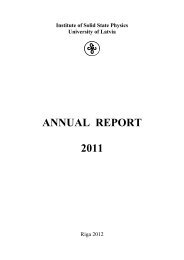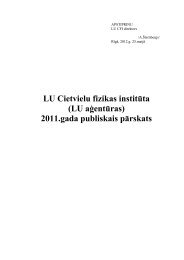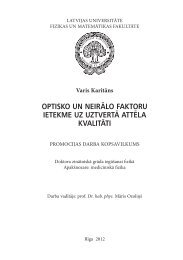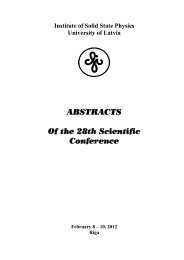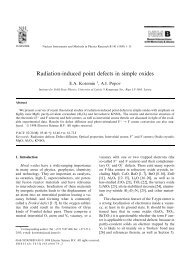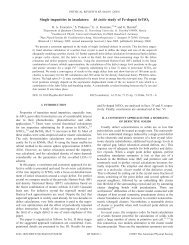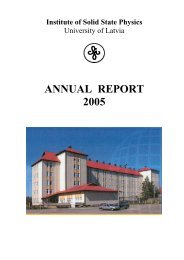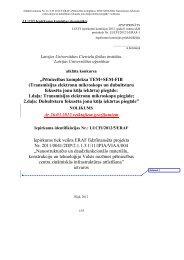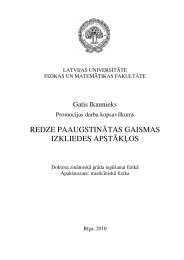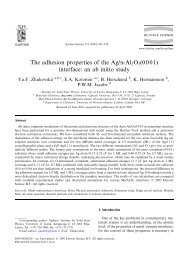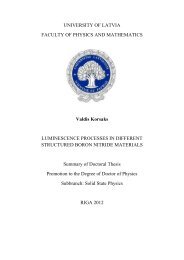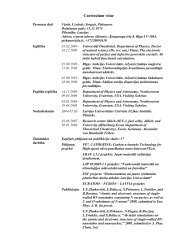Annual Report 2012 - Latvijas Universitātes Cietvielu fizikas institūts
Annual Report 2012 - Latvijas Universitātes Cietvielu fizikas institūts
Annual Report 2012 - Latvijas Universitātes Cietvielu fizikas institūts
Create successful ePaper yourself
Turn your PDF publications into a flip-book with our unique Google optimized e-Paper software.
a) b) l [110]<br />
d [110]<br />
(001)<br />
Fig. 9. Cross sectional (a) and lateral (b) images of the non-optimized large rutile-based<br />
[110]-oriented Ti atom-centered NW possessing the D 2h symmetry and containing 105<br />
formula units per NW UC, with aside (001) and ( ) facets (the former is shown in Fig.<br />
9.b). Rectangles in Fig. 9.a show borders for prism models of middle, small and smallest<br />
TiO 2 NWs (55, 21 and 3 formula units per UC, respectively). NW diameter is shown by<br />
the twice-terminated arrow (d [110] ) while its period (length of UC) is shown in Fig. 9.b as<br />
l [110] .<br />
The properties of titania nanowires are both the size and shape dependent. For direct<br />
comparison of relative stability of various 1D nanowires, we have performed large-scale<br />
calculations on their surface energy per formula unit. Values of d NW slightly increase<br />
whereas l NW are found to be reduced after NW geometry optimization. The larger is d NW ,<br />
the closer its geometry parameters as well as the band gap to those of rutile-based TiO 2<br />
bulk and non-optimized (001) and (110) slabs whereas NW surface energy approaches<br />
to that of facets terminating the nanowire. In the case of Ti atom-centered NWs, values<br />
of Δε g grow with increasing d NW while in hollow site-centered NWs, these values<br />
decrease in analogous conditions, analogously to band gaps of slabs with increasing<br />
thickness.<br />
THEORETICAL SIMULATIONS OF ELECTROMAGNTIC PROPERTIES IN<br />
CARBON NNTUBES AND GRAPHENE BASED NANOSTRUCTURES<br />
Yu.N. Shunin, Yu.F. Zhukovskii,<br />
S. Bellucci (Laboratori Nazionali di Frascati, Italy)<br />
In collaboration with Dr. S. Bellucci (Laboratori Nazionali di Frascati, Italy), we have<br />
developed the model of ‘effective bonds’ in the framework of both cluster approach<br />
based on the multiple scattering theory formalism and Landauer theory, which can allow<br />
us to predict the resistivity properties for C-Me junctions taking into account chirality<br />
effects in the interconnects of single-wall (SW) and multi-wall (MW) CNTs (Fig. 10) as<br />
well as monolayer (ML) and polylayer (PL) GNRs (Fig. 11) with the fitting metals<br />
(Me= Ni, Cu, Ag, Pd, Pt, Au) on predefined geometry of carbon nanostructure.<br />
63



